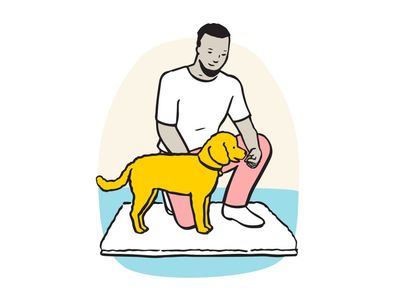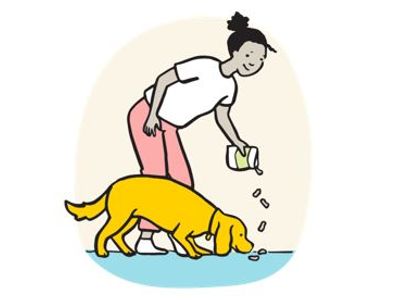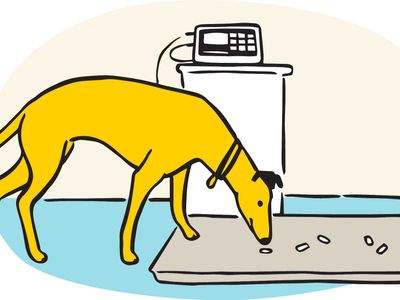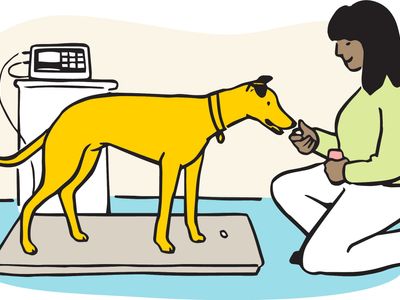How to get your dog used to being weighed on the scales
Find how to get your dog used to scales so that weighing them at the vet is quick and stress-free for both of you.
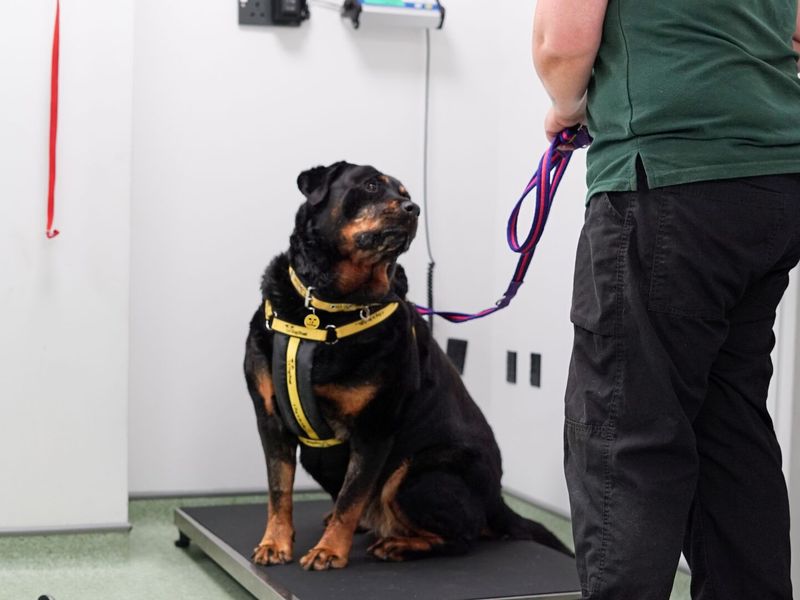
Being able to weigh your dog is essential. There are lots of reason you need to know their weight, including calculating how much food they need and what wormers and flea treatments they need. Being aware of weight gain or loss can also highlight potential health issues, or let you know you need to alter their diet.
Your vet also needs to know their weight to prescribe the right amount of medicine or anaesthetic, tailor a prescription diet if needed, and monitor their health.
Introducing your dog to the vet clinic’s scales
Many dogs find the weighing scales scary, and might resist getting on them, and struggle to stay still once on them. This can make it hard to get an accurate weight reading. To prevent your dog associating the scales with stress and fear, you can teach them that the scales can be a place where good things happen.
Speak to your vet about visiting the clinic to get your dog used to the scales. Choose a quiet time of day and make sure your dog is relaxed when entering the clinic. More advice on how to make your dog’s veterinary visit less stressful.
A step-by-step guide to getting your dog used to the scales
Get the scales ready
They should have a non-slip surface, be stable and be clean with no strong odours. This can all help your dog to feel secure. Some dogs might feel more comfortable if their own blanket is laid on the scales.
Scatter treats on the floor
Scatter some treats onto the floor and scales so your dog can explore by themselves. This will help them associate the scales with good things. Don’t pull or drag your dog towards the scales. They’ll feel safer and much more comfortable if they can investigate them at their …
Scatter treats on the scales
If your dog is calm, scatter more treats directly onto the scales and see if they will willingly step up onto the scales to eat them.
Feed them treats from your hand
When they’re on the scales, give them more treats directly from your hand. Encourage them to stay on the scales by feeding them a few treats in quick succession, so they learn that staying still is the way to get more treats. If your dog is confident and appears comfortable …
Roll a treat along the floor
Encourage them to get off the scales by rolling a treat along the floor. If they get straight back on the scales, reward them. We want them to connect being on the scales with good things happening.
What to do if your dog is very worried about getting onto the scales
If your dog is very worried, start on the floor instead of the scales themselves. You'll need lots of treats which your dog really likes.
- Get the scales or mat ready. They should have a non-slip surface, be stable and be clean with no strong odours. If the scales have a removable mat, place it on the floor away from the scales. If there isn’t a mat, use your dog’s towel or blanket.
- Choose a cue phrase like “on the scales” for your dog to associate with getting on the mat or towel. Say the phrase and scatter some treats on the floor near the mat. Let your dog sniff and eat the treats and reward them with praise and more treats.
- Repeat and gradually decrease the distance to the mat while saying the chosen phrase. Keep going until you are scattering the treats directly onto the mat and the dog is stepping onto the mat themselves. Reward them with praise and more treats from your hand.
- Once your dog is fully on the mat, wait a few seconds before rewarding them. This will encourage them to stay on the mat and wait for more treats to come. Slowly and surely, your dog is learning that being on the mat is a great place to be, so they’ll choose to stay there.
- Gradually increase the time your dog stays still before you give them another treat, until it’s enough time to record their weight.
- When your dog is confidently standing or sitting on the mat, repeat the steps and gradually move the mat nearer the scales in between repetitions. If your dog starts to get worried, go back to a distance where they were comfortable and repeat there for a little bit longer before trying to move closer again.
- Once your dog is confidently staying on the mat near the scales, lay it on top of the scales and repeat the steps. Let your dog get on the scales gradually, so they are always comfortable and can choose to back away if they prefer. Little by little is the key, with lots of praise and tasty treats. As with all other stages, if the dog starts to show discomfort, return to a previous stage at which they were comfortable and repeat there for a little bit longer.
After a while, your dog should associate your chosen phrase with walking onto the scales to get treats, waiting a few seconds (for their weight to be read), and receiving praise and more treats.
If you're still having trouble getting your dog to step willingly onto the scales, guides, speak to your vet for advice. They may be able to help or can refer you to a behaviourist if needed.
Weighing your dog with your own scales at home
Only attempt to weigh your dog at home if they are small enough to fit on your scales, or small and willing for you to pick them up and step onto the scales together. Weighing your dog at home may not be as accurate as using the scales at your vets, but it can be useful for general weight monitoring or getting an estimated weight for worm and flea treatments.
If your dog can step onto your scales comfortably, follow the steps above to get them used to it.
If you need to lift your small dog up to be able to weigh them, first teach them that being picked up is nothing to worry about. Weigh yourself and your dog together, then weigh yourself separately and deduct your weight from the combined total to see what your dog weighs.
